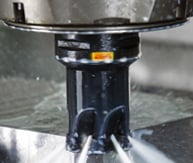Machining Titanium: What You Should Know
 Shortening machining cycle time, reducing labor costs and extending tool life can all play a major role in improving productivity and, thereby, your bottom line. While using the most advanced machine tools is certainly a key component in achieving greater productivity, it’s not the entire answer. It’s equally important to optimize all aspects of a manufacturing operation from raw materials through delivery to the customer.
Shortening machining cycle time, reducing labor costs and extending tool life can all play a major role in improving productivity and, thereby, your bottom line. While using the most advanced machine tools is certainly a key component in achieving greater productivity, it’s not the entire answer. It’s equally important to optimize all aspects of a manufacturing operation from raw materials through delivery to the customer.
In the case of materials, it’s important to consider the unique characteristics of each type of metal so the process will be as efficient as possible. Complex alloys and exotic materials pose especially daunting challenges. Case in point: machining titanium.
A popular material for use in manufacturing aerospace, medical, and other components, titanium has a unique chemical composition and a number of physical characteristics that make it more difficult to machine. One significant issue is that this material is a poor conductor of heat and, therefore, machining titanium generates greater amounts of heat than machining many other metals.
Studies show that exposure of the cutting edge to higher temperatures along with high-pressure cutting may cause premature tool wear. In addition, titanium has a tendency to smear during machining, and this can cause chips to weld to the insert, thus causing edge line problems when re-entering the cut. There’s also an increased risk of chattering because of titanium’s elasticity.
To deal with these problems, Sandvik Coromant recommends these general guidelines for machining titanium:
- Use relatively low cutting speeds
- Use sharp cutting edges
- Optimize feed rates and avoid idling while in cut
- Use large volumes of coolant, preferably at high pressure through spindle and tool
- Replace cutting edges at first sign of any wear
- Employ climb (down) milling wherever possible
In addition to selecting the right cutting tool material and following the above methods, the heart of the matter is the ability of the CNC machine tool to perform capably during the machining process. This means the machine must have a rigid spindle and tool holder to eliminate the vibrations that cause out-of-tolerance parts. It must also maintain a constant cutting feed rate, because if the spindle starts to slow down, the tool may burn up. Plus the machine’s control must be capable of maintaining consistent acceleration and deceleration, and to quickly process data to maintain peak performance.
With more than 90 years of machine tool experience, the applications experts at Gosiger can answer your questions about machining titanium and other difficult-to-machine materials. To learn more contact the nearest Gosiger facility.
 |
 |